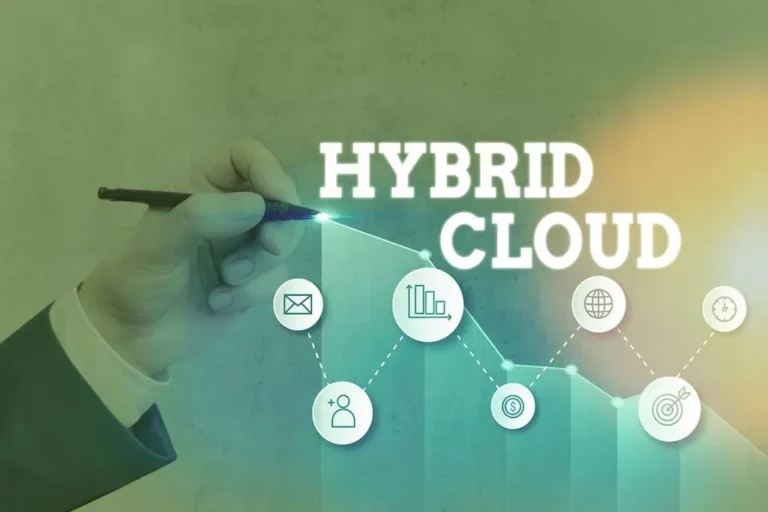The Ultimate Guide to Hybrid Cloud Computing

With the adoption of data center technologies, businesses started to update legacy systems leveraging the services offered by third-party providers. The increased popularity of distributed data processing signified a pivotal shift. Companies no longer have to invest in infrastructure, as they can utilize hybrid cloud computing (HCC) to scale up operations and run apps remotely in various environments. 56% of enterprises with revenue exceeding $500 million utilize HCC, which enables them to store user data locally, comply with regulations, and run low-latency applications.
In this article, we will analyze how service providers make it possible for business owners to build agile infrastructure, improve processing capacities, and minimize downtime.
What Is Hybrid Cloud Computing?
HCC, or hybrid cloud computing, is an operating model utilizing public ecosystems and virtual private clouds (VPC). Embracing such approaches allows businesses to migrate app workloads across both environments and access digital assets. The HCC technology is utilized by companies aiming to mitigate risks, reduce expenses, and handle tasks without investing in multi-core tools and storage.
70% of IT experts believe it’s impossible to achieve successful digital transformation without the HCC strategy. Firms employing the cloud bursting method typically host processes offline or in a private cloud to adhere to privacy regulations and access software-as-a-service (SaaS) providers to handle increased demand.
There are three main types of HCC models:
- Client-managed: VPC are deployed on-premises or in other secure locations.
- Vendor-managed: HCC products run in remote processing centers and edge ecosystems.
- Partner-managed: Trusted providers offer HCC capacities, enabling firms to access cloud computing environments (CCEs) and integrate them with on-site systems.
Powerful networking capacities are instrumental to the uninterrupted functioning of HCC. Hybrid cloud providers facilitate accessing multiple CCEs and building a reliable infrastructure with streamlined integration and intuitive orchestration tools.
Establishing a secure connection between locations becomes possible due to virtual private networks (VPN), LAN, WAN, and APIs. HCC infrastructures are based on virtualization, storage, and containerization technologies.

We are confident that we have what it takes to help you get your platform from the idea throughout design and development phases, all the way to successful deployment in a production environment!
Why Utilize Hybrid Cloud Computing?
Entities integrate HCC to leverage the public cloud capabilities while storing sensitive information locally. Below, we have outlined the key upsides of the method:
- Streamlined modernization: HCC allows firms to control the speed of migrating apps to CCEs, facilitating gradual hardware upgrading.
- Adherence to laws: Businesses strive to maintain compliance by utilizing different types of CCEs to store information in protected locations.
- Non-virtualized app deployment: While transferring some digital products to CCEs is arduous, hybrid cloud solutions enable developers to run them locally while accessing large amounts of IT sources remotely.
- Enhanced governance practices: HCC gives users control over the place where app data is stored.
- Powerful performance: Distributed applications and low-latency apps benefit from hybrid cloud computing.
- Flexibility: Developers can select the most suitable cyberinfrastructure.
- High ROI: Small and medium-sized businesses (SMBs) reduce operational costs and avoid costly investments in data centers. Large enterprises also benefit from integrating on-site infrastructure with web-based platforms.
In addition, utilizing VPC enables firms to monitor connections, configure access rights inside virtual networks, create subnets, and adjust the route table settings. Such products facilitate resource allocation and building a sustainable infrastructure. The hybrid models make it easier to leverage AI and ML advancements to expand and upgrade existing tech grids.

Examples of Hybrid Cloud Computing
Hybrid models are best suited for organizations that experiment with different CCEs and select the most efficient options for their apps and data. Companies from industries with tight regulations and strict privacy requirements utilize HCC to control how they store and handle data. The most common use cases include:
- Modernization and digitization: Service providers offer a cost-effective way to modernize IT infrastructure, migrate classified data to secure on-site servers, and ensure that apps remain accessible from any location. HCC also facilitates the employment of DevOps to optimize banking operations and enhance UX.
- Data loss minimization: Firms protect their infrastructures from issues related to hardware failure, power outages, cyber threats, and other emergencies.
- App testing: Developers access a multitude of environments and test products under different conditions.
- Cloud bursting: As many enterprises manage inconsistent application workloads, dealing with spikes in demand without investing in hardware might be challenging. However, HCC facilitates load balancing and makes it possible to reduce expenses.
- Edge analytics: The framework implies that workloads are placed close to endpoints, which results in lower latency. In a hospital setting, it streamlines patient monitoring.
AWS, Azure, Google Anthos, Nutanix, and VMware are typical examples of HCC. Developers rely on remote CCEs to employ advanced technologies, use microservices, and build containerized architecture. When selecting a provider, firms interested in cloud native development should consider a choice of available options. A hybrid architecture should foster IT resource consolidation, facilitate automated deployment to the best location, and streamline workload balancing.
Tips and Reminders for Utilizing Hybrid Cloud Computing
Before ordering HCC offerings, organizations should estimate the predicted workloads and analyze processes to select the most suitable migration strategy. As there is no one-fits-all approach, it’s pivotal to follow these steps to discover a custom solution:
- Set objectives: After analyzing the current approach, think about possible areas of improvement and consider platforms that will help you reach the set goals.
- Consider workloads: Select the right CCE for your workloads to expedite deployment.
- Analyze architecture: Even though workloads differ depending on the industry, learning about common patterns allows organizations to use various locations the most effectively.
- Select network technologies: Finding the right topology enables companies to establish a secure connection between different CCEs.
These steps enable companies to leverage hybrid cloud computing and build sustainable infrastructures using remote processing capabilities. Building a viable migration strategy necessitates creating a flexible IT architecture that includes on-prem and third-party resources. Building a multi-cloud prevents entities from becoming dependable on specific vendors.
Conclusion
By embracing hybrid cloud computing, firms expand the scope of their activities at affordable prices and deploy apps in optimal ecosystems. Unlike VPC and public cloud sites, HCC platforms allow businesses to control assets, upgrade apps, and enhance user experiences (UX) due to secure connections. The Global Cloud Team includes experts with years of experience who build custom HCC systems allowing organizations to get full control over data storage and security settings. Contact our professionals to learn more about our software development services and discover how to leverage the power of innovative technologies for maximum gain.
Top Articles
ABC of DevOps Testing: Types, Best Practices, and Everything You Need to Know
I am here to help you!
Explore the possibility to hire a dedicated R&D team that helps your company to scale product development.






